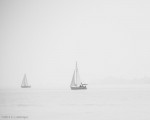In German, all nouns have a grammatical gender and there’s no predicting which gender a noun will be: der Tisch, “the table” is masculine, die Tür, “the door” is feminine, das Auge, “the eye” is neuter. It’s a matter of memorization and practice in using the words until the forms come naturally.
FWIW, der Hals, die Nase, das Ohr are a nice set with one example of each gender. The English corresponds to “throat” , “nose”, “ear” respectively. I once noticed that, and found those easy to remember, since in the reverse order it’s a standard American English grouping for a medical specialty (i.e. ear, nose and throat doctors). So, when I wanted to write an example sentence on an exam, and wanted to be sure I had the proper gender of a word in order to get the grammar correct, I would often try to employ one of these words. It’s not as easy as it sounds making random sentences off the cuff with ear, nose, and throat, however.
But I digress. I bring all this up because in German there are two words spelled See, pronounced like the second syllable of “Jose,” i.e. “zay”.
The different meanings are instantly recognizable in certain grammatical constructions if you know that the different grammatical genders of these words, since that tells you which is which. Here are the words with the definitive article in its basic form for each gender:
- Der See – (masculine) “lake”
- Die See – (feminine) “sea”
After the preposition an, meaning “at”, the masculine and feminine nouns get different forms of those definite articles:
- an + dem= am = masculine “at the”
- an + der = an der = feminine “at the”
Note that you don’t ever get the am form before a feminine noun.
Now that we know that, look back at the title of this post, Not all “am See”. The word See there is preceded by am. So we know that it must mean the masculine word “lake”, not “sea”.
See, this is why knowing the gender of words is important and is supposed to make things easier.
Of course, this is also why German is hard, IMHO, because if you don’t remember those genders you’re sunk, whether it’s the lake or the sea. 😉
In any case, this was a long way ’round of saying that the title simply means that all the photos today were taken at a lake. Specifically, they were taken at the Bodensee, which is a lake, not a sea.
Of course, now that you know that See by itself means lake, you probably assume the name of that body of water in English would be Lake Boden, right?
Good guess — but, no. Never assume, eh? Here’s an explanation of why it’s called Lake Constance, taken from the English language Wikipedia entry:
After the Council of Constance, the Catholic world gave the lake its current name, after the city Constantia (Konstanz), that, in turn, was named after a Roman emperor (either Constantius Chlorus or his grandson Constantius II). The German name, Bodensee, derives on the other hand from the place name Bodman (today’s Bodman-Ludwigshafen) just north of Konstanz.
Got that?
BTW, the Imperia statue from yesterday’s post was actually made to commemorate that same Council of Constance, which happened back in the 1400s. Well, at least the statue is somehow a tribute to Balzac’s satire on that council, apparently.
Anyway, getting back to the photos below… They have been greatly enhanced on the computer. The flat, white, misty day wasn’t ideal for regular photos, so just for fun I played with some settings, both in the camera at the moment I took the shots, and also later on the computer. See what you think.
- Am Bodensee – Photo #1
- Am Bodensee – Photo #2
- Am Bodensee – Photo #3
- Am Bodensee – Photo #4
- Am Bodensee – Photo #5
- Am Bodensee – Photo #6






